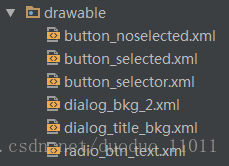Android开发之自定义对话框
由于系统自带的对话框不好看,于是本人就自定义了一个对话框,以后有类似的就可以直接使用啦。先上效果图:
1,布局文件dialog_clear_normal.xml
<?xml version="1.0" encoding="utf-8"?>
<LinearLayout xmlns:android="http://schemas.android.com/apk/res/android"
android:layout_width="200dp"
android:layout_height="wrap_content"
android:background="@drawable/dialog_bkg_2"
android:orientation="vertical">
<TextView
android:id="@+id/dialog_title"
android:layout_width="match_parent"
android:layout_height="40dp"
android:background="@drawable/dialog_title_bkg"
android:gravity="center"
android:paddingBottom="4dp"
android:paddingTop="4dp"
android:text="标题"
android:textColor="@color/textColor_black"
android:textSize="20sp" />
<LinearLayout
android:id="@+id/dialog_content"
android:layout_width="fill_parent"
android:layout_height="wrap_content"
android:gravity="center">
<TextView
android:id="@+id/dialog_message"
android:layout_width="match_parent"
android:layout_height="wrap_content"
android:layout_margin="16dp"
android:text="您确定要删除么?"
android:textColor="@drawable/radio_btn_text"
android:textSize="18sp" />
</LinearLayout>
<LinearLayout
android:layout_width="match_parent"
android:layout_height="35dp"
android:layout_margin="16dp"
android:orientation="horizontal">
<Button
android:id="@+id/btn_dialog_ok"
style="@style/btn_style"
android:layout_width="wrap_content"
android:layout_height="match_parent"
android:layout_marginLeft="16dp"
android:layout_marginRight="16dp"
android:layout_weight="1"
android:text="确定"
android:textAllCaps="false"
android:textSize="18sp" />
<Button
android:id="@+id/btn_dialog_cancel"
style="@style/btn_style"
android:layout_width="wrap_content"
android:layout_height="match_parent"
android:layout_marginLeft="16dp"
android:layout_marginRight="16dp"
android:layout_weight="1"
android:text="取消"
android:textAllCaps="false"
android:textSize="18sp" />
</LinearLayout>
</LinearLayout>
2,文件夹values/colors.xml
<?xml version="1.0" encoding="utf-8"?>
<resources>
<color name="colorPrimary">#3F51B5</color>
<color name="colorPrimaryDark">#303F9F</color>
<color name="colorAccent">#FF4081</color>
<color name="white">#ffffff</color>
<color name="black">#000000</color>
<color name="textColor_black">#222222</color>
<color name="transparent">#00000000</color>
<color name="title_bkg">#48a1ff</color>
<color name="btn_unselect">#dddddd</color>
<color name="btn_selected">#aaaaaa</color>
<color name="right_key_unselect">#80dddddd</color>
<color name="right_key_selected">#80aaaaaa</color>
<color name="right_key_textColor">#80222222</color>
<color name="bkg_num_color">#40ffffff</color>
<color name="nn">#0000ff</color>
</resources>
3,文件夹values/styles.xml
<resources>
<!-- Base application theme. -->
<style name="AppTheme" parent="Theme.AppCompat.Light.DarkActionBar">
<!-- Customize your theme here. -->
<item name="colorPrimary">@color/colorPrimary</item>
<item name="colorPrimaryDark">@color/colorPrimaryDark</item>
<item name="colorAccent">@color/colorAccent</item>
</style>
<style name="btn_style">
<item name="android:background">@drawable/button_selector</item>
<item name="android:textSize">20sp</item>
<item name="android:textColor">@color/textColor_black</item>
<item name="android:textAllCaps">false</item>
</style>
<style name="Dialog" parent="android:style/Theme.Dialog">
<item name="android:background">#00000000</item>
<item name="android:windowBackground">@android:color/transparent</item>
<item name="android:windowNoTitle">true</item>
<item name="android:windowIsFloating">true</item>
</style>
</resources>
4,文件夹drawable/的一些xml文件:

1)
<?xml version="1.0" encoding="utf-8"?>
<shape xmlns:android="http://schemas.android.com/apk/res/android" >
<solid android:color="@color/btn_unselect" />
<stroke
android:width="1px"
android:color="@color/textColor_black" />
<corners
android:radius="4dp" />
</shape>2)
<?xml version="1.0" encoding="utf-8"?>
<shape xmlns:android="http://schemas.android.com/apk/res/android" >
<!--<solid android:color="@color/rippelColor" />-->
<solid android:color="@color/btn_selected" />
<stroke
android:width="1px"
android:color="@color/textColor_black" />
<corners
android:radius="4dp" />
</shape>3)
<?xml version="1.0" encoding="utf-8"?>
<selector xmlns:android="http://schemas.android.com/apk/res/android">
<item android:drawable="@drawable/button_selected" android:state_selected="true" />
<item android:drawable="@drawable/button_selected" android:state_focused="true" />
<item android:drawable="@drawable/button_selected" android:state_pressed="true" />
<item android:drawable="@drawable/button_selected" android:state_checked="true"/>
<item android:drawable="@drawable/button_noselected" />
</selector>
4)
<?xml version="1.0" encoding="utf-8"?>
<shape xmlns:android="http://schemas.android.com/apk/res/android" >
<solid android:color="#ffffff" />
<corners
android:radius="8dp" />
</shape>5)
<?xml version="1.0" encoding="utf-8"?>
<shape xmlns:android="http://schemas.android.com/apk/res/android" >
<solid android:color="@color/title_bkg" />
<corners
android:topLeftRadius="8dp"
android:topRightRadius="8dp"/>
</shape>6)
<?xml version="1.0" encoding="utf-8"?>
<selector xmlns:android="http://schemas.android.com/apk/res/android">
<item android:color="@color/textColor_black" android:state_checked="false" />
<item android:color="@color/title_bkg" android:state_checked="true" />
</selector>
5,自定义一个对话框的类:
package com.gyq.dialog;
import android.app.Dialog;
import android.content.Context;
import android.content.DialogInterface;
import android.view.LayoutInflater;
import android.view.View;
import android.view.ViewGroup;
import android.widget.Button;
import android.widget.LinearLayout;
import android.widget.TextView;
/**
* ${DESC}
* author: gyq
* create at 2017/2/7 15:33
*/
public class CustomDialog extends Dialog {
public CustomDialog(Context context) {
super(context);
}
public CustomDialog(Context context, int theme) {
super(context, theme);
}
public static class Builder {
private Context context;
private String title;
private String message;
private String positiveButtonText;
private String negativeButtonText;
private View contentView;
private DialogInterface.OnClickListener positiveButtonClickListener;
private DialogInterface.OnClickListener negativeButtonClickListener;
public Builder(Context context) {
this.context = context;
}
public Builder setMessage(String message) {
this.message = message;
return this;
}
/**
* Set the Dialog message from resource
*
* @param
* @return
*/
public Builder setMessage(int message) {
this.message = (String) context.getText(message);
return this;
}
/**
* Set the Dialog title from resource
*
* @param title
* @return
*/
public Builder setTitle(int title) {
this.title = (String) context.getText(title);
return this;
}
/**
* Set the Dialog title from String
*
* @param title
* @return
*/
public Builder setTitle(String title) {
this.title = title;
return this;
}
public Builder setContentView(View v) {
this.contentView = v;
return this;
}
/**
* Set the positive button resource and it's listener
*
* @param positiveButtonText
* @return
*/
public Builder setPositiveButton(int positiveButtonText,
DialogInterface.OnClickListener listener) {
this.positiveButtonText = (String) context
.getText(positiveButtonText);
this.positiveButtonClickListener = listener;
return this;
}
public Builder setPositiveButton(String positiveButtonText,
DialogInterface.OnClickListener listener) {
this.positiveButtonText = positiveButtonText;
this.positiveButtonClickListener = listener;
return this;
}
public Builder setNegativeButton(int negativeButtonText,
DialogInterface.OnClickListener listener) {
this.negativeButtonText = (String) context
.getText(negativeButtonText);
this.negativeButtonClickListener = listener;
return this;
}
public Builder setNegativeButton(String negativeButtonText,
DialogInterface.OnClickListener listener) {
this.negativeButtonText = negativeButtonText;
this.negativeButtonClickListener = listener;
return this;
}
public CustomDialog create() {
LayoutInflater inflater = (LayoutInflater) context
.getSystemService(Context.LAYOUT_INFLATER_SERVICE);
// instantiate the dialog with the custom Theme
final CustomDialog dialog = new CustomDialog(context,R.style.Dialog);
View layout = inflater.inflate(R.layout.dialog_clear_normal, null);
dialog.addContentView(layout, new ViewGroup.LayoutParams(
ViewGroup.LayoutParams.MATCH_PARENT, ViewGroup.LayoutParams.WRAP_CONTENT));
// set the dialog title
((TextView) layout.findViewById(R.id.dialog_title)).setText(title);
// set the confirm button
if (positiveButtonText != null) {
((Button) layout.findViewById(R.id.btn_dialog_ok))
.setText(positiveButtonText);
if (positiveButtonClickListener != null) {
((Button) layout.findViewById(R.id.btn_dialog_ok))
.setOnClickListener(new View.OnClickListener() {
public void onClick(View v) {
positiveButtonClickListener.onClick(dialog,
DialogInterface.BUTTON_POSITIVE);
}
});
}
} else {
// if no confirm button just set the visibility to GONE
layout.findViewById(R.id.btn_dialog_ok).setVisibility(
View.GONE);
}
// set the cancel button
if (negativeButtonText != null) {
((Button) layout.findViewById(R.id.btn_dialog_cancel))
.setText(negativeButtonText);
if (negativeButtonClickListener != null) {
((Button) layout.findViewById(R.id.btn_dialog_cancel))
.setOnClickListener(new View.OnClickListener() {
public void onClick(View v) {
negativeButtonClickListener.onClick(dialog,
DialogInterface.BUTTON_NEGATIVE);
}
});
}
} else {
// if no confirm button just set the visibility to GONE
layout.findViewById(R.id.btn_dialog_cancel).setVisibility(
View.GONE);
}
// set the content message
if (message != null) {
((TextView) layout.findViewById(R.id.dialog_message)).setText(message);
} else if (contentView != null) {
// if no message set
// add the contentView to the dialog body
((LinearLayout) layout.findViewById(R.id.dialog_content))
.removeAllViews();
((LinearLayout) layout.findViewById(R.id.dialog_content)).addView(
contentView, new ViewGroup.LayoutParams(
ViewGroup.LayoutParams.MATCH_PARENT,
ViewGroup.LayoutParams.MATCH_PARENT));
}
dialog.setContentView(layout);
return dialog;
}
}
}
7,使用这个dialog:
CustomDialog.Builder builder = new CustomDialog.Builder(this);
builder.setTitle("提示");
builder.setMessage("你确定要清空么?");
builder.setPositiveButton("确定", new DialogInterface.OnClickListener() {
@Override
public void onClick(DialogInterface dialog, int which) {
dialog.dismiss();
}
});
builder.setNegativeButton("取消", new DialogInterface.OnClickListener() {
@Override
public void onClick(DialogInterface dialog, int which) {
dialog.dismiss();
}
});
builder.create().show();小结:这个自定义的对话宽,点击外面也会消失。有阴影部分,效果还是蛮好看的。
Android开发之自定义对话框的更多相关文章
- android开发之自定义组件
android开发之自定义组件 一:自定义组件: 我认为,自定义组件就是android给我们提供的的一个空白的可以编辑的图片,它帮助我们实现的我们想要的界面,也就是通过自定义组件我们可以把我们要登入的 ...
- android 开发AlertDialog.builder对话框的实现
AndroidAPI提供了Dialog对话框控件,但google明确指出不建议开发者只是使用Dialog来创建对话框,而应该自定义对话框或者使用API中提供的Dialog的子类,如AlertDialo ...
- Android开发之自定义的ListView(UITableViewController)
Android开发中的ListView, 顾名方法思义,就是表视图.表示图在iOS开发中就是TableView.两者虽然名称不一样,但是其使用方法,使用场景以及该控件的功能都极为相似,都是用来展示大量 ...
- Android开发之自定义组件和接口回调
说到自定义控件不得不提的就是接口回调,在Android开发中接口回调用的还是蛮多的.在这篇博客开始的时候呢,我想聊一下iOS的自定义控件.在iOS中自定义控件的思路是继承自UIView, 在UIVie ...
- Android开发之自定义的ProgressDialog
package com.example.dialog; import android.app.ProgressDialog; import android.content.Context; /** * ...
- Android开发之自定义Dialog简单实现
本文着重研究了自定义对话框,通过一下步骤即可清晰的理解原理,通过更改界面设置和style类型,可以应用在各种各样适合自己的App中. 首先来看一下效果图: 首先是activity的界面 点击了上述图片 ...
- Android开发之自定义局部导航菜单
如今,要实现导航功能方案有很多.比如: 1.用3.0+自带的Toolbar + Fragment导航. 2.用Tabhost实现导航.小弟学浅,就只用过这两种方案实现导航. 但是这两种方案都有一个很明 ...
- Android开发进阶——自定义View的使用及其原理探索
在Android开发中,系统提供给我们的UI控件是有限的,当我们需要使用一些特殊的控件的时候,只靠系统提供的控件,可能无法达到我们想要的效果,这时,就需要我们自定义一些控件,来完成我们想要的效果了.下 ...
- Android开发之自定义圆角矩形图片ImageView的实现
android中的ImageView只能显示矩形的图片,这样一来不能满足我们其他的需求,比如要显示圆角矩形的图片,这个时候,我们就需要自定义ImageView了,其原理就是首先获取到图片的Bitmap ...
随机推荐
- 大数据学习——Linux-SSH报错:Could not resolve hostname centos02: Temporary failure in name resolution
https://blog.csdn.net/mcb520wf/article/details/83303792 随笔异常 ssh: Could not resolve hostname centos0 ...
- NYOJ 237 游戏高手的烦恼
游戏高手的烦恼时间限制:1000 ms | 内存限制:65535 KB难度:5描述有一位传说级游戏高手,在闲暇时间里玩起了一个小游戏,游戏中,一个n*n的方块形区域里有许多敌人,玩家可以使用炸弹炸掉某 ...
- [NOIP1998] 提高组 洛谷P1012 拼数
题目描述 设有n个正整数(n≤20),将它们联接成一排,组成一个最大的多位整数. 例如:n=3时,3个整数13,312,343联接成的最大整数为:34331213 又如:n=4时,4个整数7,13,4 ...
- 《TCP/IP详解卷1:协议》——第3章 IP:网际协议(转载)
1.引言 IP是TCP/IP协议族中最核心的协议.所有的TCP.UDP.ICMP及IGMP数据都以IP数据报格式传输.IP提供不可靠. 无连接的数据报传送服务. (1)不可靠 它不能保证IP数据报能成 ...
- spring boot 没有主清单属性
- Maven 手动添加本地jar包
mvn install:install-file -Dfile=jar绝对路径 -DgroupId=项目组织唯一的标识符 -DartifactId=项目的唯一的标识符 -Dversion=jar版本 ...
- I NEED A OFFER!---hdu1203(01背包)
http://acm.hdu.edu.cn/showproblem.php?pid=1203 Problem Description Speakless很早就想出国,现在他已经考完了所有需要的考 ...
- HDU 1114 【DP】
题意: 给你空钱袋的质量和装满钱的钱袋的质量. 给你先行的n种货币的面值和质量. 问钱包里的钱最少是多少. 如果质量不可行,输出impossible. 思路: 完全背包. 屌丝有个地方没想通,就是如何 ...
- Python的描述符
1.描述符的定义 描述符是与特定属性互相绑定的一种协议,通过方法被触发修改属性,这些方法包括__get__(),__set__(),__delete__().将这些方法定义在类中,即可实现描述符 2. ...
- Openwrt挂载NTFS硬盘提示“只读”错误的解决方法!
Openwrt是基于Linux代码编写,只支持NTFS格式硬盘的只读权限,否则当挂载的NTFS硬盘写入超过2M左右,就会出现"error:read-only file system" ...

